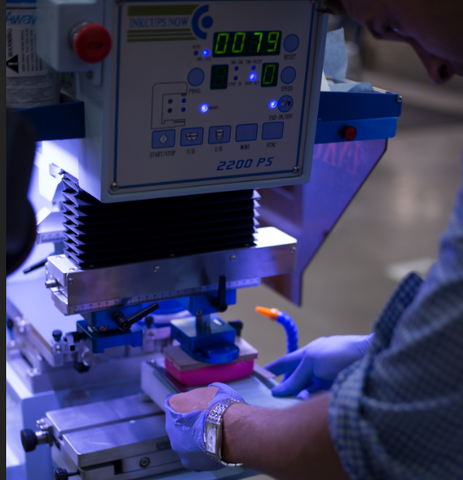Custom Pad Printing Explained
Custom Pad Printing Explained
Ever wonder how custom designs or company logos get onto small, unusually shaped or rounded objects? The answer more often than not is pad printing. Pad printing is a custom decoration method that uses special ink and soft pads to press your logo onto the surface of a product. Make sure to check out our complete pad printing capabilities to see how you can use pad printed promotional products to take your branding to the next level.
How Does Pad Printing Work?
While pad printing is typically used to decorate more complex and unconventional surfaces, it is actually one of the more straightforward decoration methods. Pad printing is accomplished by transferring an image onto your product using a silicone pad and ink. You can think of it sort of like a spongey stamp!
Step by Step Guide to Pad Printing
- Create your logo or design – using graphic design software, your company logo or custom design is digitized and saved into a file format that your die cutting machine can read.
- Etch your design – your corporate logo or design is etched into a metal plate, or cliché. The image is either etched or laser engraved into the cliché depending on the material of the cliché.
- Position your products – the products you are personalizing are placed into a special offset press where they will soon be stamped with your logo.
- Fill the cliché – the engraved space in the cliché acts as an ink reservoir and is filled with the proper ink for your product. The cliché is inked either by an open inkwell doctoring system or by a closed ink cup that slides across the etched logo.
- Ink the pad – next, the silicone pad is pressed into the ink reservoir, picking up ink in the shape of your logo or design.
- Stamp your product – using an offset press, the inked printing pad is pressed onto your product to create your custom printed logo! The squishy nature of the silicone pad allows the pad to conform to any shape or form.
- Dry the ink – pad printing ink is designed to dry quickly, so sometimes this step isn’t required. However, for some surfaces either cold or warm air is blown onto the ink for a few seconds to dry it.
- Stamp of approval – once your logo is applied to the product it is checked for quality by one of our pad printing experts and then packaged and shipped to your door!
What Equipment & Supplies is Needed for Pad Printing?
- Computer – a computer with design software is used to mock up your logo or design.
- Laser Engraver/ Etcher – this is used to imprint your company logo or custom design into the metal plate that the ink sits in before it’s applied to the pad.
- Cliché – the cliché is the metal plate that is engraved with your logo or design and filled with ink to be transferred onto the printing pad. This is usually made of a polymer coating on a metal backing or from hardened steel.
- Offset press – an offset press is used for 2 steps in the pad printing process. First, to press the silicone printing pad into an inset plate to pick up the ink for your design. Next, it's issued to “stamp” your logo or design onto the surface of your product.
- Printing Pads – these are made of silicone and come in a wide variety of shapes and sizes, so they can be applied to any product. The chemical properties of the silicone used in the pad allow the ink to temporarily stick to the silicone but still fully release from the pad when pressed onto the surface of your product.
- Pad Printing Ink – there are a few different types of inks that are used in pad printing depending on the demands that are placed on the ink. Each ink type used in pad printing are specially designed to be more adhesive to the desired surface than the silicone pad. Pad printing inks are also engineered to walk the line between preventing evaporation while still drying quickly on the product. Ink types used are one component inks, two component inks, mixed inks and LED-inks. Check out our Pad Printing PMS Color Chart to see pad printing color options.
- Cleaning supplies – cleaning solutions like Acetone, Alcohol or another thinning solvent is used to clean the silicone pads between uses. Don’t forget to wear protective cleaning gear if you’re doing this at home!
Next Steps
It’s no longer a mystery how those cool designs and logos get added to unusually shaped objects like golf balls and pens. Now that you know how it works, be sure to check out our complete custom pad printing capabilities. Looking for something else? Read up on our comprehensive Custom Decoration Methods Guide to see everything we can do or contact us to get all of your customization questions answered!

